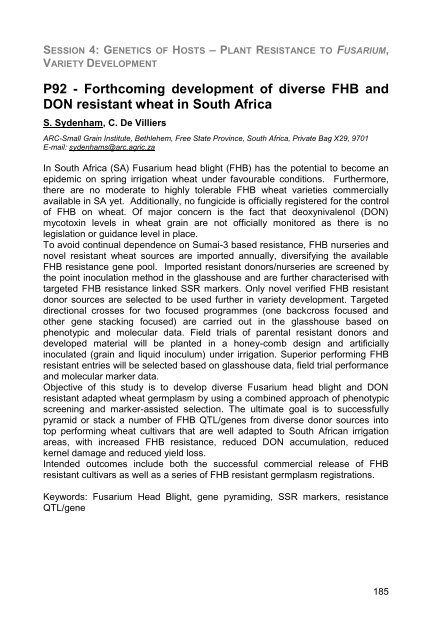EFS12- Book of abstracts - Contact
EFS12- Book of abstracts - Contact
EFS12- Book of abstracts - Contact
Create successful ePaper yourself
Turn your PDF publications into a flip-book with our unique Google optimized e-Paper software.
SESSION 4: GENETICS OF HOSTS – PLANT RESISTANCE TO FUSARIUM,<br />
VARIETY DEVELOPMENT<br />
P92 - Forthcoming development <strong>of</strong> diverse FHB and<br />
DON resistant wheat in South Africa<br />
S. Sydenham, C. De Villiers<br />
ARC-Small Grain Institute, Bethlehem, Free State Province, South Africa, Private Bag X29, 9701<br />
E-mail: sydenhams@arc.agric.za<br />
In South Africa (SA) Fusarium head blight (FHB) has the potential to become an<br />
epidemic on spring irrigation wheat under favourable conditions. Furthermore,<br />
there are no moderate to highly tolerable FHB wheat varieties commercially<br />
available in SA yet. Additionally, no fungicide is <strong>of</strong>ficially registered for the control<br />
<strong>of</strong> FHB on wheat. Of major concern is the fact that deoxynivalenol (DON)<br />
mycotoxin levels in wheat grain are not <strong>of</strong>ficially monitored as there is no<br />
legislation or guidance level in place.<br />
To avoid continual dependence on Sumai-3 based resistance, FHB nurseries and<br />
novel resistant wheat sources are imported annually, diversifying the available<br />
FHB resistance gene pool. Imported resistant donors/nurseries are screened by<br />
the point inoculation method in the glasshouse and are further characterised with<br />
targeted FHB resistance linked SSR markers. Only novel verified FHB resistant<br />
donor sources are selected to be used further in variety development. Targeted<br />
directional crosses for two focused programmes (one backcross focused and<br />
other gene stacking focused) are carried out in the glasshouse based on<br />
phenotypic and molecular data. Field trials <strong>of</strong> parental resistant donors and<br />
developed material will be planted in a honey-comb design and artificially<br />
inoculated (grain and liquid inoculum) under irrigation. Superior performing FHB<br />
resistant entries will be selected based on glasshouse data, field trial performance<br />
and molecular marker data.<br />
Objective <strong>of</strong> this study is to develop diverse Fusarium head blight and DON<br />
resistant adapted wheat germplasm by using a combined approach <strong>of</strong> phenotypic<br />
screening and marker-assisted selection. The ultimate goal is to successfully<br />
pyramid or stack a number <strong>of</strong> FHB QTL/genes from diverse donor sources into<br />
top performing wheat cultivars that are well adapted to South African irrigation<br />
areas, with increased FHB resistance, reduced DON accumulation, reduced<br />
kernel damage and reduced yield loss.<br />
Intended outcomes include both the successful commercial release <strong>of</strong> FHB<br />
resistant cultivars as well as a series <strong>of</strong> FHB resistant germplasm registrations.<br />
Keywords: Fusarium Head Blight, gene pyramiding, SSR markers, resistance<br />
QTL/gene<br />
185
















![Présentation CRB-anim [Mode de compatibilité] - Inra](https://img.yumpu.com/17418636/1/190x135/presentation-crb-anim-mode-de-compatibilite-inra.jpg?quality=85)